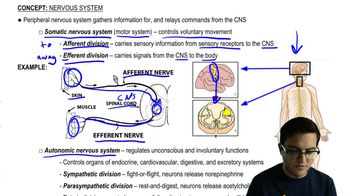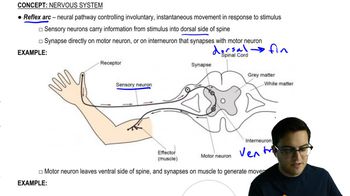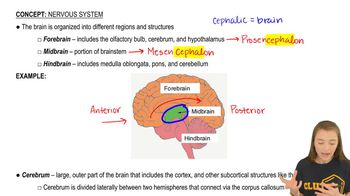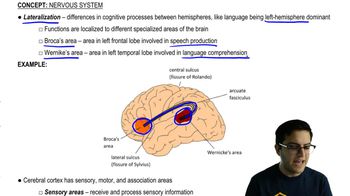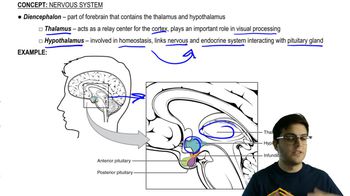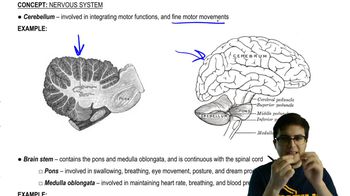Table of contents
- 1. Introduction to Biology2h 42m
- 2. Chemistry3h 40m
- 3. Water1h 26m
- 4. Biomolecules2h 23m
- 5. Cell Components2h 26m
- 6. The Membrane2h 31m
- 7. Energy and Metabolism2h 0m
- 8. Respiration2h 40m
- 9. Photosynthesis2h 49m
- 10. Cell Signaling59m
- 11. Cell Division2h 47m
- 12. Meiosis2h 0m
- 13. Mendelian Genetics4h 44m
- Introduction to Mendel's Experiments7m
- Genotype vs. Phenotype17m
- Punnett Squares13m
- Mendel's Experiments26m
- Mendel's Laws18m
- Monohybrid Crosses19m
- Test Crosses14m
- Dihybrid Crosses20m
- Punnett Square Probability26m
- Incomplete Dominance vs. Codominance20m
- Epistasis7m
- Non-Mendelian Genetics12m
- Pedigrees6m
- Autosomal Inheritance21m
- Sex-Linked Inheritance43m
- X-Inactivation9m
- 14. DNA Synthesis2h 27m
- 15. Gene Expression3h 20m
- 16. Regulation of Expression3h 31m
- Introduction to Regulation of Gene Expression13m
- Prokaryotic Gene Regulation via Operons27m
- The Lac Operon21m
- Glucose's Impact on Lac Operon25m
- The Trp Operon20m
- Review of the Lac Operon & Trp Operon11m
- Introduction to Eukaryotic Gene Regulation9m
- Eukaryotic Chromatin Modifications16m
- Eukaryotic Transcriptional Control22m
- Eukaryotic Post-Transcriptional Regulation28m
- Eukaryotic Post-Translational Regulation13m
- 17. Viruses37m
- 18. Biotechnology2h 58m
- 19. Genomics17m
- 20. Development1h 5m
- 21. Evolution3h 1m
- 22. Evolution of Populations3h 52m
- 23. Speciation1h 37m
- 24. History of Life on Earth2h 6m
- 25. Phylogeny2h 31m
- 26. Prokaryotes4h 59m
- 27. Protists1h 12m
- 28. Plants1h 22m
- 29. Fungi36m
- 30. Overview of Animals34m
- 31. Invertebrates1h 2m
- 32. Vertebrates50m
- 33. Plant Anatomy1h 3m
- 34. Vascular Plant Transport1h 2m
- 35. Soil37m
- 36. Plant Reproduction47m
- 37. Plant Sensation and Response1h 9m
- 38. Animal Form and Function1h 19m
- 39. Digestive System1h 10m
- 40. Circulatory System1h 57m
- 41. Immune System1h 12m
- 42. Osmoregulation and Excretion50m
- 43. Endocrine System1h 4m
- 44. Animal Reproduction1h 2m
- 45. Nervous System1h 55m
- 46. Sensory Systems46m
- 47. Muscle Systems23m
- 48. Ecology3h 11m
- Introduction to Ecology20m
- Biogeography14m
- Earth's Climate Patterns50m
- Introduction to Terrestrial Biomes10m
- Terrestrial Biomes: Near Equator13m
- Terrestrial Biomes: Temperate Regions10m
- Terrestrial Biomes: Northern Regions15m
- Introduction to Aquatic Biomes27m
- Freshwater Aquatic Biomes14m
- Marine Aquatic Biomes13m
- 49. Animal Behavior28m
- 50. Population Ecology3h 41m
- Introduction to Population Ecology28m
- Population Sampling Methods23m
- Life History12m
- Population Demography17m
- Factors Limiting Population Growth14m
- Introduction to Population Growth Models22m
- Linear Population Growth6m
- Exponential Population Growth29m
- Logistic Population Growth32m
- r/K Selection10m
- The Human Population22m
- 51. Community Ecology2h 46m
- Introduction to Community Ecology2m
- Introduction to Community Interactions9m
- Community Interactions: Competition (-/-)38m
- Community Interactions: Exploitation (+/-)23m
- Community Interactions: Mutualism (+/+) & Commensalism (+/0)9m
- Community Structure35m
- Community Dynamics26m
- Geographic Impact on Communities21m
- 52. Ecosystems2h 36m
- 53. Conservation Biology24m
45. Nervous System
Central and Peripheral Nervous System
Problem 8`
Textbook Question
Why is memory thought to involve changes in particular synapses?
a. At some synapses, more neurotransmitters are released after learning takes place.
b. At some synapses, a different type of neurotransmitter is released after learning takes place.
c. When researchers stimulated certain neurons electrically, individuals replayed memories.
d. When researchers changed synapses in the brains of patients during surgery, the patients' memories changed.
 Verified step by step guidance
Verified step by step guidance1
Understand the role of synapses in neural communication: Synapses are the junctions between neurons where neurotransmitters are released to transmit signals. Changes in synapses can affect how signals are transmitted and processed in the brain.
Explore the concept of synaptic plasticity: Synaptic plasticity refers to the ability of synapses to strengthen or weaken over time, in response to increases or decreases in their activity. This is a fundamental mechanism underlying learning and memory.
Consider the impact of neurotransmitter release: After learning takes place, some synapses may release more neurotransmitters, enhancing the communication between neurons and potentially strengthening the memory trace.
Examine the evidence from research studies: Researchers have found that stimulating certain neurons electrically can lead to the replay of memories, suggesting that specific synapses are involved in memory recall.
Analyze the effects of synaptic changes during surgery: Studies have shown that altering synapses in the brain during surgery can lead to changes in patients' memories, indicating that synapses play a crucial role in storing and modifying memories.
 Verified video answer for a similar problem:
Verified video answer for a similar problem:This video solution was recommended by our tutors as helpful for the problem above
Video duration:
2mPlay a video:
Was this helpful?
Key Concepts
Here are the essential concepts you must grasp in order to answer the question correctly.
Synaptic Plasticity
Synaptic plasticity refers to the ability of synapses to strengthen or weaken over time, in response to increases or decreases in their activity. This is a fundamental mechanism underlying learning and memory, as changes in synaptic strength can alter the flow of information through neural circuits, thereby encoding new memories.
Recommended video:
Guided course

Phenotypic Plasticity
Neurotransmitter Release
Neurotransmitter release is the process by which signaling molecules are released from neurons to transmit signals across synapses. Changes in the amount or type of neurotransmitter released can affect synaptic strength and are thought to be involved in the formation and storage of memories, as they modify the communication between neurons.
Recommended video:
Guided course

Neurotransmitters
Neural Stimulation and Memory Recall
Neural stimulation involves activating neurons through electrical impulses, which can lead to the recall of memories. This suggests that specific patterns of neural activity are associated with particular memories, and stimulating these patterns can trigger memory retrieval, highlighting the role of synaptic changes in memory storage and recall.
Recommended video:
Guided course

Neuroplasticity, Learning, and Memory

 6:53m
6:53mWatch next
Master Organization of the Nervous System with a bite sized video explanation from Jason
Start learningRelated Videos
Related Practice



